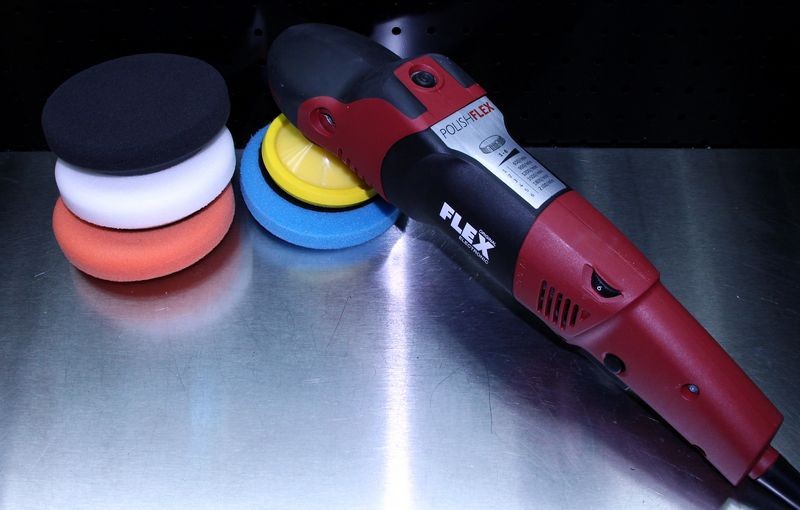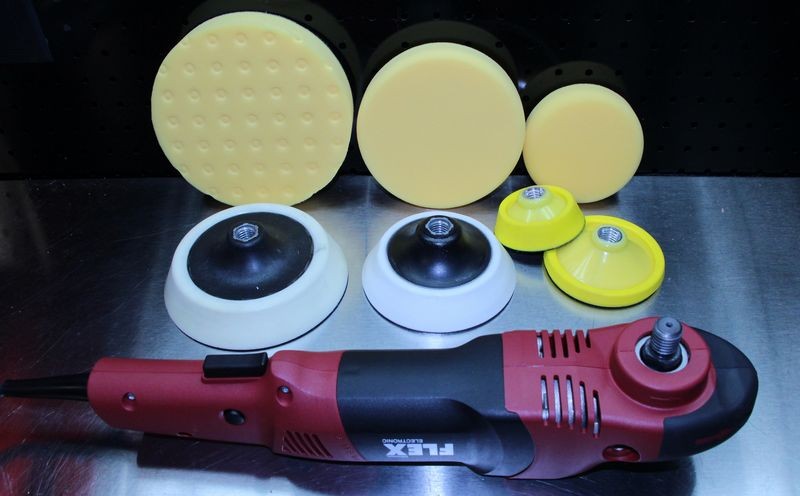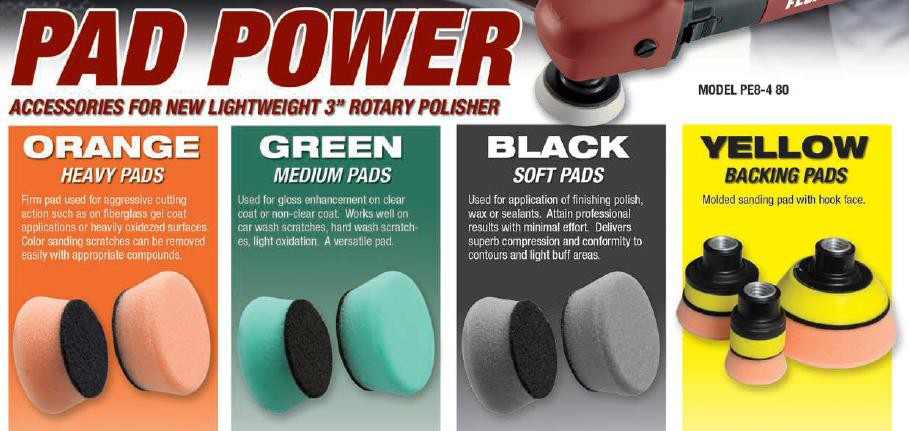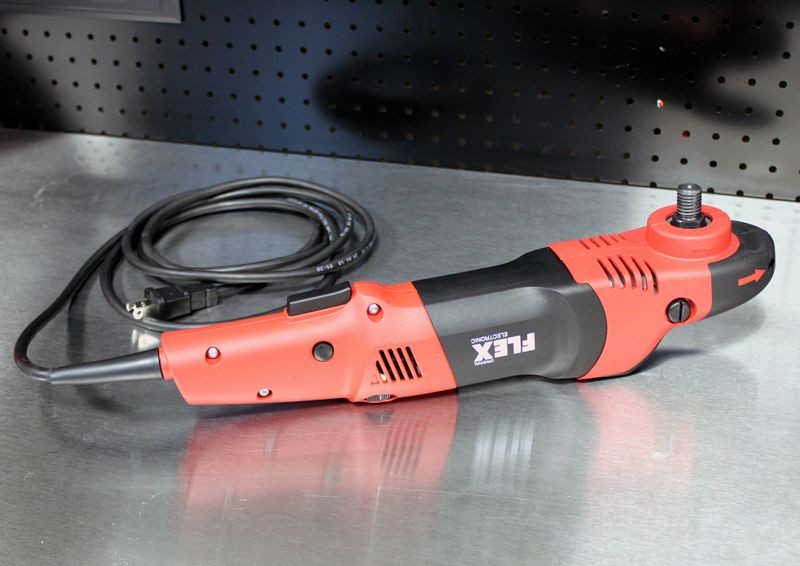 Thanks: 0
 Likes: 0
 Dislikes: 0
-
Rotary newbie, need pad advice
i just added a Dewalt 849x to my arsenal and i am looking for some advice or guidance on pad selection. my main reason for ading a rotary was to recude my work time on heavy correctio vehicles and to get in all of the tight spaces and heavy concave panels that DA's just don't like. to start i am looking at starting witha small 3-4 inch setup and a 6.5-7.5 inch setup. i just need help determining what pad style i should use with the rotary, LC CCS, Smart Pads, Curves pads, flat pads..... were should i start, and what should i wait to invest in later?
-
Re: Rotary newbie, need pad advice
I love the 3M perfect it line. Pads and compounds not cheap but work wonders and are body shop safe. I prefer their double sided pads in six inch. The white compounding pad cuts great in my opinion
-
Super Member

Re: Rotary newbie, need pad advice
I use the 3m pads every day and yes they are fantastic! I believe the double sided pads require an adaptor. I like to use a wool pad prior to the white foam.
-
Super Member

Re: Rotary newbie, need pad advice
Not to confuse your decision but i absolutely love the LC Hybrid pads on my rotary. I run both 5" pads and 3" (reg flats) pads on it. A recent post by Mike P. suggested 6.5" pads on a Flex 3401 due to its forced rotation being able to work that size just fine. I think i'll add some in my next order to cut time on larger panels.
Personally, i have liked the smaller diameter 5" Hybrids to get a better feel with each section i work with my rotary but rotaries can drive larger sizes. If time is your primary consideration, that might help too! I also like my wool pads for faster cut on trashed paint. Again...fast.
As for tighter areas, i also like my smaller backing plate and switch it out and run smaller pads for those areas. My next purchase will be a Flex PE8 so i can dedicate a machine on the fly. My current approach is to do my test spot(s), decide on my process and then "cut in" all the tight areas first with 3"ers. That involves changing out my BP and then attack the larger panels. Not that it takes much time but i still want a dedicated smaller unit on my cart to just do stuff faster if i encounter a scratch here or there.
(sorry i missed your post back in January).
-
Re: Rotary newbie, need pad advice
Hi Matt,
Welcome to the rotary buffer. While the trend has been towards orbital polishers there will always be some steps where the rotary buffer rules. My new boat detailing book shares a lot of tips on using rotary buffers that would apply to working on cars.
I have my first rotary on display in my office. I used it till it gave up the ghost and buffed out a LOT of cars in the 20 years it held up.
Below is an article I wrote about a year ago for pads I like with the Flex PE14 with links to all the pads and backing plates. Check out what I say about "flexible" backing plates and be sure to get both a nylon pad cleaning brush and a steel pad cleaning spur.
The MOST imporant thing about buffing successfully with a rotary buffer is keeping your pad clean.
Here you go...
My recommended buffing pads for the Flex PE14
One of our forum members asked me which pads and backing plates I would recommend for the Flex PE14. I get this question fairly often so below is a collection of what I would consider the minimum collection to have for the ability to tackle any project in your garage.
First and top recommendation
If you're brand new to using a rotary buffer then here's some free advice...
Small pads are easier to control and thus easier learn with when first starting out using a rotary buffer. It will be easier to learn how to hold and guide a rotary buffer over both flat panels and curved panels. So get some good small foam buffing pads and a good backing plate.
Here are three foam pads that work exceedingly well with the Flex PE14
Lake Country 5" Hybrid Pads in Orange/Cutting, White/All purpose polishing, and Black/Finishing.
Link to 5" Hybrid Pads

4" Flexible Backing Plate
You'll also need a small backing plate because the velcro backing on the back of the 5" LC Hybrid Pads is 4" in diameter. For this the 3 3/4" Lake Country Flexible Rotary Buffer Backing Plate fits perfect. The backing plate in the picture above and the picture below is a 3 3/4" LC Flexible Backing Plate. Because it's a smidgen under size it's easy to visually align to the back of these pads.
Link to 3 3/4" Flexible Rotary Buffer Backing Plate

Medium size foam buffing pads
The trend for years now has been smaller pads for all tools and that includes the rotary buffer. In fact I'd say the 6" to 7" foam buffing pads are the new 8" to 11" foam buffing pads that were popular from the 1960's through to the year 2000.
As you gain experience and hone your skills with the rotary buffer you're going to want to use larger pads for large body panels like the roof, hood, trunk lid, doors, etc.
Below are the Lake Country 6.5" Hybrid Foam Buffing Pads. These pads work great with the Flex PE14 Rotary Buffer.
Lake Country 6.5" Hybrid Pads in Orange/Cutting, White/All purpose polishing, and Black/Finishing.
Link to 6.5" Hybrid Pads


Small Wool Cutting Pad
The great feature about the Flex PE14 is that it's quiet when operating but also its lightweight and compact size. This makes it great for doing heavy correction work to thin panels, intricate areas and complicated components.
For this I like to use the Lake Country 3.5" DuroWool 100% Twisted Wool Cutting Pads with the Lake Country 2 7/8" Flexible Rotary Backing Plate.
Link to 3.5" DuroWool 100% Twisted Wool Cutting Pad
Link to 2 7/8" Flexible Rotary Buffer Backing Plate


Large Wool Cutting Pad
Technically the pad I'm recommending is a "finishing" pad not a "cutting" pad but here's the deal.
First - Fiber pad cut more aggressively than foam pads because each of the individual fibers that make up a wool pad are a type of abrasive in and of themselves and each fiber can and will cut the paint. So the fiber itself is a type of abrasive and this is why guys that finish out with only wool pads on rotary buffers leave holograms in their customer's paint.
Second - The difference between a wool cutting pad and a wool finishing pad is the degree of aggressiveness. In the BIG PICTURE when comparing wool pads to foam pads and in the context of using these pads on a rotary buffer, either type cutting or finishing is going to do a GREAT job of abrading or cutting the surface compared to any foam pad. This is key to doing the correction step in the fastest and most effective way.
If you work in a body shop and have to cut new paint jobs all day long every day then by all means get a wool cutting pad.
If you're detailing cars and thus not normally wetsanding the paint first, then simply by using a wool finishing pad for any heavy or major correction job, this will put you miles ahead time-wise versus using a foam cutting pad.
Plus wool pads cut cooler than foam cutting pads and this is important because it's not good to heat up clearcoat paints. Even though you might read someone on another forum say something like,
You need to heat the clearcoat up in order break down the abrasives
or
You need to heat the clearcoat up in order to re-flow the paint
Both of these statements and practices are wrong and this is called destructive paint polishing.
(See page 124 of The Complete Guide to a Show Car Finish)
So if you're mostly doing reconditioning work aka detailing cars, then you'll do fine and be safer plus be able to do any follow up polishing steps faster by sticking with the pad I recommend below instead of a full-on, hardcore wool cutting pad.
Flex recommends using 8" wool pads and smaller with the Flex PE14 so the below wool pad is perfect at 7.5" and is called the Lake Country 7.5" Electrified Sheepskin Final Polishing Pad.
Electrified?
The word electrified means Lake Country has taken the extra step to electrify the wool which removes the natural sharp barbs found in wool creating a pad that cuts fast but finishes with less scouring of the paint. This is a real benefit when buffing thin, scratch-sensitive clearcoat finishes.
Note: I see a few guys come to this forum and recommend using a brand of black wool pads so just to note, these pads have the barbs.
Link to 7.5" Electrified Wool Finishing Pad

Medium Size Backing Plate
You'll also want a flexible backing plate, here's a good one and Meguiar's also makes a great one. This is the 6" Flex-Foam HD Rotary Backing Plate.
Link to 6" Flex-Foam HD Rotary Backing Plate
Meguiar's 6" Solo Easy Buff W66 Rotary Backing Plate

Steel Pad Cleaning Spur
In all my detailing classes (and as a personal best practice), I teach people the most important thing to do when using any polisher and especially a rotary buffer is to clean your pad often. For a wool pad you want a steel pad cleaning spur like the one I show in the picture below.
Link to steel pad cleaning spur

Small Precision Foam Buffing Pads
Meguiar's 4" foam buffing pads work great with the Flex PE14 and the key to their excellent performance is not only the foam resin used to make the pads but the tapered design.
Tapered pads don't twist-in during use like cylindrical pads and this maintains the full face of the pad in contact with the paint plus prevents the backing plate from becoming exposed to the surface being buffed. Cylindrical pads tend to twist-in and can be used successfully as long as you focus on the task at hand. Tapered pads work better and are safer when doing intricate, detailed work.
You'll also want to get their backing plate for use with these pads.
Link to Meguiar's Maroon Foam Cutting Pads
Link to Meguiar's Yellow Foam Polishing Pads
Link to Meguiar's Black 4" Foam Finishing Pads
Link to Meguiar's 3" Rotary Backing Plate


Gold Foam Jewelling Pads
Hey who doesn't love the look of paint that has been meticulously jeweled to perfection? I know I do!
But in order to jewel paint to perfection with a rotary buffer you must use a super soft, gold jewelling pad to avoid instilling even the faintest of holograms. Below are 3 gold jewelling pad and they all will work but flat pads are always the safest choice when jewelling paint because the flat surface avoids any potential for excess product or foreign particles to deposit in design voids in the surface of non flat pads.
I've used the CCS pads successfully just be sure to clean and inspect the collapsed cell divots often.
My favorite types of pad are pads with a simple flat surface design. There's the least amount of risk for problems since the face is completely flat and they are a lot easier and faster to clean since you can brush 100% of the face of the pad using a nylon pad conditioning brush.
Gold Jewelling Pads
Link to CCS 6.5 inch Super Soft Gold Jewelling Pad
For the Flat 5.5 and 4" Gold Jewelling Pads call 1-800-869-3011 as these are not listed on the AG store and there's only one or two boxes left in our inventory.
The backing plates shown below work great with these pads, in order from left to right
Link to 6" Flex-Foam HD Rotary Backing Plate
Link to 5" Flex-Foam HD Rotary Backing Plate
Link to 2 7/8" Flexible Rotary Buffer Backing Plate
Note: The Lake Country 3 3/4" Flexible Backing Plate fits the back of the 4" Gold Jewelling Pad but there's not much safety margin from the outside of the pad to the outside of the backing plate and these pad are so soft that they compress very easily, especially the smaller pads and even more so when they start to become wet with product so for this reason I use and recommend the even smaller 3 3/4" LC yellow backing plate. See the picture below to see what I'm talking about.



A Jewelling Machine
The 5.5" Gold Jewelling Pad with the 5" Flex-Foam HD Backing Plate is the perfect combination for the Flex PE14 for jewelling paint to perfection.

Flex PE8 Foam Buffing Pads
Flex has introduced the new PE8 Kompakt Rotary Polisher and a line of 3", 2" and 1" pads with matching backing plates.
These new pad and backing plates will also work with the PE14.
I had the opportunity to use these at the 2014 SEMA Show in Las Vegas and I can tell you straight up these new pads are going to be a huge hit because the market, (that's you and me) have been hoping and waiting for smaller pads for decades.
 This image has been resized. Click this bar to view the full image. The original image is sized %1%2 and weights %3. This image has been resized. Click this bar to view the full image. The original image is sized %1%2 and weights %3.
Nobody has these pads in stock yet so here's three ways to be notified when they are in stock.
So there's my recommendations for both wool and foam buffing pads for your Flex PE14 and if you don't have a Flex PE14 yet I highly recommend getting one. You won't regret it and even if you already have another rotary buffer I guarantee you'll become like me and when you need to use a rotary buffer the Flex PE14 will be the first rotary buffer you reach for. In fact, I even have an article about this topic.
The Flex PE14 Rotary Polisher - The rotary I grab first...
On Autogeek.net
Link to the Flex PE14 Rotary Polisher
Here's mine...

The second production unit...

Hope that helps....

Similar Threads
-
By ljbrandt in forum Rotary Buffers
Replies: 16
Last Post: 05-15-2016, 12:37 AM
-
By flawlesss1 in forum Rotary Buffers
Replies: 25
Last Post: 11-14-2011, 04:38 PM
-
By nomercy346 in forum Ask your detailing questions!
Replies: 9
Last Post: 02-24-2010, 05:31 PM
-
By pricha00 in forum Auto Detailing 101
Replies: 13
Last Post: 07-27-2008, 02:55 AM
-
By koibybrian in forum Auto Detailing 101
Replies: 11
Last Post: 04-28-2007, 01:16 PM
 Members who have read this thread: 0
Members who have read this thread: 0
There are no members to list at the moment.
 Posting Permissions
Posting Permissions
- You may not post new threads
- You may not post replies
- You may not post attachments
- You may not edit your posts
-
Forum Rules
|
| S |
M |
T |
W |
T |
F |
S |
| 31 |
1
|
2
|
3
|
4
|
5
|
6
|
|
7
|
8
|
9
|
10
|
11
|
12
|
13
|
|
14
|
15
|
16
|
17
|
18
|
19
|
20
|
|
21
|
22
|
23
|
24
|
25
|
26
|
27
|
|
28
|
29
|
30
| 1 | 2 | 3 | 4 |
|












 Thanks:
Thanks:  Likes:
Likes:  Dislikes:
Dislikes: 

 Reply With Quote
Reply With Quote



Bookmarks